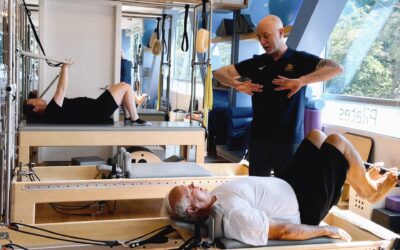Healthy Pelvic Floor Program For Women
Your pelvic floor region is made up of multiple layers of muscles, which are controlled by your nervous system, and supported by layers of fascia/connective tissue which connect the muscles to the bony skeleton.
There are many different unsettling symptoms that indicate your pelvic floor may not be functioning in the most optimal way – these include experiencing things like:
- unexpectedly leaking urine or feces – known as “incontinence”
- inability to control “passing gas”
- feeling a heaviness in your pelvic floor, or like things are “falling down” or “falling out” of your pelvis – known as “prolapse”
- frequent need to urinate
- experiencing painful intercourse, or pain in your pelvic floor region with specific activities like sitting and walking – this can include pain more in the front of your pelvic floor region, or pain in the tailbone region
A physiotherapist who has completed special training to perform internal pelvic floor (PF) assessment and treatment techniques can assess your pelvic floor and determine if your pelvic floor is dysfunctional. This includes testing:

- the ability to recruit and “find” your PF muscles and turn them on symmetrically
- the endurance of your PF muscles – how long can you sustain a contraction?
- the strength of your PF muscles
- if there is over-activity in your pelvic floor muscles – called “hypertonicity” – which can be a source of pelvic floor pain
- palpating for tissue changes or deficits in the fascia or muscles
- testing pudendal nerve function
This specific pelvic floor assessment gives us insight into how your pelvic floor is functioning. However, at Synergy Physio, we feel this is only part of the picture.
Research has shown that it is common for women with pelvic floor problems to also experience low back pain or pain in the back of the pelvis, respiratory problems, and/or gastrointestinal or digestive problems (Smith et al, 2014). This illustrates how your pelvic floor does not function in isolation, but is influenced by other systems in your body, and also by dysfunction in other regions of the body – that is, all of your body systems and regions are Connected.
Early on in her career, Synergy’s founder, physiotherapist Dr. LJ Lee, recognized that patient’s movement strategies – the way they coordinate multiple different muscles in the body to create movement – had a significant impact on the function of the pelvic floor. Function of the pelvic floor muscles is also uniquely influenced by the thorax, by many different mechanisms. All this means that how you may have adapted to an old ankle injury or an old shoulder injury could change the way you move, change how you recruit the muscles of your trunk – including your core – and therefore change the daily forces and influences on your pelvic floor function.
Thus, at Synergy Physio, if you have problems with your pelvic floor, we not only perform a specific PF assessment, but we first do a complete whole-body, ConnectTherapy™ assessment. We then combine the findings from our whole-body assessment and the internal pelvic floor assessment to determine the most effective and efficient treatment plan for you, designed to match your individual needs.
“Kegels” – to squeeze or not to squeeze?
“Kegels” are exercises that involve contracting your pelvic floor muscles. They were created by and named after the gynecologist, Dr. Arnold Kegel in 1948 and were used as an alternative to surgery. To this day, health professionals prescribe kegels to women with pelvic floor concerns. Kegels do help some women, but seeing as we are all individuals, other women may not benefit to the same degree.
So, have you tried to do kegel exercises before and been unable to?
You are not alone – this is a common experience for women with pelvic floor problems. What you may not realize, is that dysfunction in other areas of your body can be a barrier to you finding and recruiting your pelvic floor muscles. Your pelvic floor muscles are an important part of your “core” – they are supposed to work in a coordinated fashion with your abdominal muscles and your diaphragm. Your abdominals and diaphragm originate and receive their nerve supply from your thorax. So dysfunction higher up in your trunk – even all the way up to your neck – can affect the way you coordinate your pelvic floor with your other core muscles. A common reason for having difficulty with contracting your pelvic floor is overusing your upper body muscles and creating too much pressure in your abdomen and down onto your pelvic floor. You can read more about how we optimize core function here.
Thus, the most efficient and effective way to be able to do a “kegel” is by addressing the underlying causes and barriers in the rest of your body that are in the way. As well, you experience your pelvic floor problems during activities that involve your whole body – running, jumping, moving. So only assessing your pelvic floor without looking at how you move during function gives very limited information – we need to assess more than just your pelvic floor to know what forces are acting on your floor and find the true underlying cause of your problems. Along the way, this means not only will we figure out how to improve your pelvic floor function, but how to get rid of those nagging low back or neck issues.
This is why, at Synergy Physio + Pilates, we do more than just teach you how to do kegel exercises – because kegels aren’t always effective nor ideal for everyone to do.
Education
As you can see, there is lots to learn about how to support a Healthy Pelvic Floor. So our Healthy Pelvic Floor Program also involves helping you understand the various influences on your pelvic floor function – things like why and how it’s important to avoid straining when trying to have a bowel movement, and how to change your bowel and bladder habits to support your pelvic floor health. We do this education in a group lecture setting, so that your one-on-one physiotherapy sessions can be focused on your individual needs.
The Program
As a new patient to the Healthy Pelvic Floor Program, you will be asked to:
-
- book a Whole Body Initial Pelvic Floor assessment with one of our Healthy Pelvic Floor therapists – Nelly Yockell or Erin Lynn.
- based on information your therapist gains from your initial assessment – hearing about your symptoms and challenges, your goals, and gaining information from a whole body assessment, your Pelvic Health therapist will determine if and when an internal exam should be done – they will give you these recommendations at the end of your Initial assessment
- given the high demand on our therapists’ schedules, the front desk will recommend that you book your Initial Assessment and then at least 3 subsequent appointments right away, so we can get your treatment plan started
We’re working on putting together an online version of our education lecture that we have previously run in the clinic – more information to be posted here soon.
Feel free to contact us if you have questions about our Healthy Pelvic Floor program.
References:
Smith MD, Russell A, Hodges PW. The relationship between incontinence, breathing disorders, gastrointestinal symptoms, and back pain in women: a longitudinal cohort study. Clin J Pain, 2014: Feb; 30(2): 162-7.
Our Blog
Insights and Tips from Our Experts
Next Group Physio Healthy Bones™ Class starts Wed. Sept 13th – Sign up now!
Are you interested in improving your balance, stability, muscle strength and bone health? Then this class is for...
Shockwave Therapy – What is it & How can it help?
Shockwave therapy has become increasingly common as a treatment option for musculoskeletal conditions to assist...
Running and Pregnancy
Running has become a very popular sport, and more than half of recreational runners are women. For runners who...



